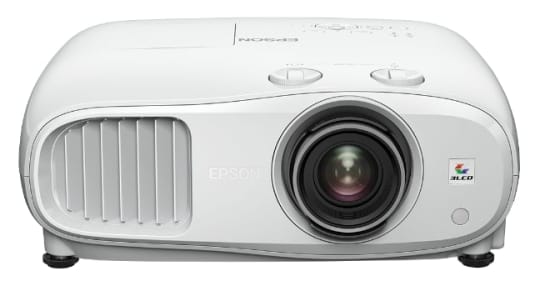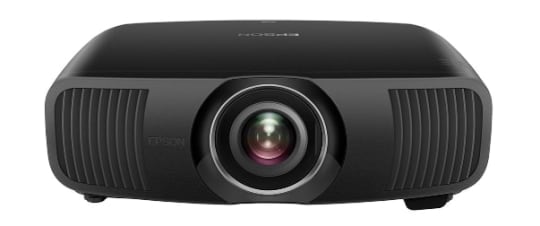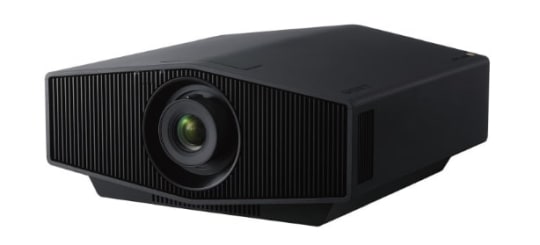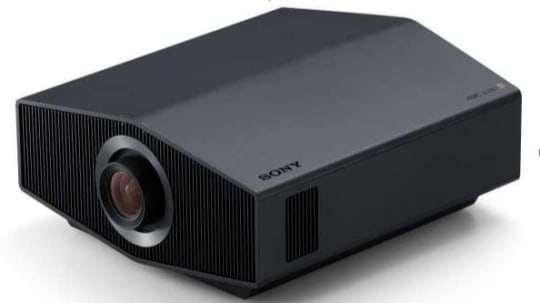Best 4K Projectors

When buying a projector for corporate use, home cinema, or gaming, a 4K projector is the way to go.
4K projectors stand out as not only do they provide a high-quality image, but they also take up less space and provide an even more significant impact than televisions, thanks to the larger display.
Our guide below looks at some of the best 4K projectors on the market so you can choose the one that’s right for you.
But before we do that, let’s start with the basics.
What is a 4K projector?
4K projectors offer ultra-high-definition images with nearly four times the number of pixels of 1080p projectors. Compared with the best HD projectors in the market, 4k projectors provide a clearer display.
Why choose a 4K projector?
When choosing a 4k projector, you must compare it with the competing technologies to make sure that you are making the right decision.
A 4k projector’s leading competitor is a standard flatscreen television. A 4k projector offers more flexibility as it can be placed anywhere, unlike a television that is limited to a wall or countertop. While this gives you plenty of options, setting a 4k projector against an even, white-coloured wall is preferable.
While television can also offer 4K resolution, the compact form, easy installation, flexibility, and increasing affordability of projectors in general in the market, are the factors that make a 4K projector your best bet.
What to look for in a 4K projector
Have you decided to buy a 4K projector? If so, consider these factors before you buy!
Resolution
Choose a 4K projector with high resolution. This is because the resolution governs how clear the projected image will be. The higher the number of pixels, the higher the resolution and the more vivid the content of the image.
Regarding 4K technology, there are generally two resolutions we are concerned with: 3840×2160 or 4096×2160 pixels.
Audio
The idea that projectors lack sound is outdated. The advanced 4K projectors come with excellent onboard speakers. These speakers are often so powerful that they can easily cover a large living room with lush audio.
So, you don’t need to make an additional investment in a standalone sound system.
Brightness
The brightness of a projector is measured in lumens. The higher the lumen rating, the brighter and costlier the projector, even if all other variables remain the same.
It’s worth mentioning that projectors have two types of lumens specifications: one for colour brightness and one for white brightness.
If, however, only one lumens rating is provided, then it defines the white brightness of the projector. In such a scenario, the colour brightness is about one-third of the lumens stated.
Features
When buying a projector, you need to ensure that it has all the necessary features to make it your ideal 4K projector. While the resolution, audio, and brightness are described above, here are some other crucial features of a 4K projector that you should keep an eye out for:
- Throw ratio: the width of the image relative to the throw distance. For instance, if the throw ratio is 2.0, for each foot of image width, the projector needs to be 2 feet away.
- Contrast ratio: the difference between the screen’s brightest white and the darkest black. A high contrast ratio is essential for a great image.
- Inputs: the types of inputs the projector has. You’ll want to ensure the projector has the correct input for your devices.
- In addition, keep the warranty, price and customer reviews in mind when choosing a 4K projector.
Best budget option: Optoma ZK400

Now that you know the necessary factors to consider when buying a 4K projector, let’s get to the details of our best 4K projector picks.
To begin with, Optoma ZK400 is our pick for those with corporate needs but a small budget.
As a business owner, it’s best to have a high-end but affordable projector for your meeting rooms, events, and tradeshows. That’s where Optoma ZK400 comes in handy.
This compact 4K UHD laser projector is maintenance-free, which makes it your best budget option. Moreover, you can easily install it in just about any orientation in your meeting rooms.
The Optoma ZK400 has a DuracCore laser technology that delivers up to 30,000 hours of virtually maintenance-free laser light source. So, the image quality is inevitably excellent.
Key features
- Brightness of 4000 ANSI lumens
- 4K UHD resolution, HDR and HLG compatible
- DuraCore laser technology, meaning 30,000 hours of almost maintenance-free operation
- Small form factor with quiet operation
- Video inputs of 3 x HDMI 2.0 and 1 x USB-A
- Watts per speaker of 10W
- 1.5-1.66:1 throw lens
Best high-end option: Panasonic PT-FRQ50WEJ

If you have a flexible budget, a great option is the Panasonic PT-FRQ50WEJ.
With a brightness of 5200 ANSI lumens, this 4K projector provides a laser light source for up to 20,000 hours under normal operating conditions.
Furthermore, it has a versatile 2.0x optical zoom with a 1.46-2.93:1 1 lens and a wide-range V/H lens shift for accurate yet simple image placement.
Whether it is a home cinema, gaming, business meetings, or something else, you can use this 4K projector as a high-end option for your needs.
Key features
- Brightness of 5200 ANSI lumens
- Quad pixel drive for detail-rich 4K images with high frame rates
- Vivid and accurate colours
- Dynamic contrast that elevates image realism
- 20,000 hours of maintenance-free operation
- Multi-Screen Support System
- Data-cloning function
- Flexible 2.0x zoom lens with wide-Range V/H lens-shift
- Preactivated upgrade kit for Geometry Manager Pro
An alternative high-end option: BenQ LK952

When it comes to high-end 4K projector options, BenQ LK952 is second on our list.
Not only does it generate intense BlueCore laser-powered brightness for 20,000 hours of maintenance-free operation, but it also conjures up a crystal-clear 4K resolution for compelling visuals.
It offers multiple screen applications through HDMI and has a flexible, versatile installation due to the horizontal and vertical lens shift features.
As with Panasonic PT-FRQ50WEJ, this 4K projector can perfectly fulfil your needs, including home cinema, gaming, and business meetings.
Key features
- Brightness of up to 5000 ANSI Lumens
- Excellent image details and colour integrity from DLP technology
- Optimised image quality with 4K Image Amplifying technology
- Hyper-realistic video quality empowered by HDR10 technology
- Precision-aligned high-output laser light source
- Hermetically sealed DLP chip
- 3,000,000:1 dynamic contrast ratio
- 4K UHD image quality for flawless presentation with subtle details
- The secondary yellow-infused colour wheel
- A throw ratio of 1.36-2.18:1
Best for a home cinema experience: Epson EH-TW7000

For a super comfy atmosphere in your home where you can relish 4K movies with your loved ones, refer to our best home cinema 4K projectors below, namely Epson EH-TW7000, Epson EH-LS12000B, Sony VPL-XW5000B, and Sony VPL-XW7000.
Taking your home cinema experience to the next level has been made easier than ever with this 4K UHD projector, Epson EH-TW7000.
Its high light output of 3000 lumens, contrast ratio of 40,000:1, and frame interpolation can provide bright, sharp, and fast-moving images.
This projector can create a display of up to 500 inches. The lens shift, zoom, and keystone correction ensure that this display is precisely where you want it to be.
The two HDMI ports on the projector allow you to display 4K content from a set-top box, games console, Blu-ray player, tablet or other devices.
Key features
- Brightness of 3000 lumens
- Resolution of 4K PRO-UHD 1 for clear, crisp images
- High-quality and affordable content
- Easy set-up and content access
- An engaging big-screen experience
- Manual vertical/horizontal lens shift feature
- 5,000 hours of lamp life in Eco mode
- A throw ratio of 1.32 – 2.15:1
An alternative home cinema option: Epson EH-LS12000B

For a state-of-the-art home cinema experience, Epson EH-LS12000B is another one on our list of top 4K projectors.
This projector delivers phenomenal image quality and colour brightness through technologies such as 3LCD laser projection, 4K resolution, and HDR10+ support.
Its bright to jet-black colour-rich quality images result in an unmatched realistic experience.
Do you want to relish an engaging home cinema experience? Well, look no further!
Key features
- 4K resolution
- Colour and white brightness of 2700
- Frame interpolation of up to 4K @ 60fps
- 3 LCD laser projection
- HDR10+ support
- Wide lens shift that makes its installation flexible
- High contrast ratio of 2,500,000:1
- Practical functionality as well as convenient connectivity
- 1.35-2.84:1 throw ratio
- 2.1x optical zoom
- Extensive vertical/horizontal lens shift
Another alternative home cinema option: Sony VPL-XW5000ES/B

Do you want to upgrade your home cinema experience with brighter and more vibrant images? If so, Sony VPL-XW5000ES/B is your choice.
To enhance your experience and make it even more immersive, this projector comes with the native 4K SXRD (Silicon X-tal Reflective Display) panel and Wide Dynamic Range Optics.
Key features
- Native 4K UHD resolution
- All-new Native 4K SXRD panel
- 1.6x optical zoom
- Long-lasting 2,000 lumens brightness
- IMAX Enhanced Picture Mode
- Extensive vertical/horizontal lens shift
- 1.38-2.21:1 lens ratio
- BRAVIA X1 Ultimate image processor
- Triluminous Pro algorithm that can detect colour from saturation, brightness and hue to reproduce natural shades in every detail
- An environmental-friendly design
- 95% DCI-P3 colour gamut accuracy
Another alternative home cinema option: Sony VPL-XW7000ES/B

Are you looking for an authentic big-screen experience that displays crisp images full of lifelike colours whether you are in your living room or media room? If so, the Sony VPL-XW7000ES/B is a great option.
The integration of this projector with newly developed Native 4K SXRD and Wide Dynamic Range Optics makes its brightness even more compatible with your surroundings. Delivering 200 nits on a 150-inch screen, it brings you a truly immersive experience.
Key features
- The brightness of 3,200 ANSI Lumens
- Flagship-level X1 Ultimate for the projector that brings you the best of Sony’s image processing
- Infinite black contrast
- Native 4K SXRD panel that provides full 4K resolution with 4096 x 2160 pixels
- Dual database processing
- Wide Dynamic Range optics contribute to a compact design that achieves a 95% DCI-P3 wide colour gamut.
- A throw ratio of 1.35-2.84:1
- 2.1x optical zoom
- Extensive vertical/horizontal lens shift
- Dynamic HDR Enhancer that processes HDR content scene by scene
- ARC-F optics for razor-sharp clarity
- Digital Focus Optimizer that corrects the image quality so that the focus is better than ever, even in the corners
- Object-based HDR Remaster that analyses the colour of individual objects on the screen and adjusts the contrast
- Object-based Super Resolution technology that detects individual objects in a picture and enhances each one for exceptional accuracy and detail
Best for Gaming: BenQ TK700STi

Are you an avid gamer who wants to maximise your gaming experience? Well, we have just the right 4K projector rooted out for you
To take your gaming world to the next level, look no further than BenQ TK700STi.
Having a DLP projection system, this projector supports 4K at 60 Hz. On top of that, there is an exceptionally low unsurpassed response time of 16ms.
You can also elevate the frequency to 120 Hz if you are good with an HD output. With the game mode activated, there would only be a negligible input lag of 4ms at 240 Hz.
Besides gaming, this projector is also an excellent choice for movies and TV shows.
Key features
- 4K UHD resolution
- Projection size of up to 120 inches
- Audio of 5W
- The brightness of 3000 lumens
- Video inputs of 2x HDMI 2.0 (with ARC), 1x Audio OUT, 1x USB, 1x RS-232
- Short throw 0.9-1.08:1 lens
Frequently Asked Questions
How big should my 4K projector picture be?
It all boils down to the size of your wall or projection screen. You can measure the wall in your home and see if it lines up with the image size of your projector.
4K Projectors offer flexible images, so to give you an idea, these images can typically range from 40 inches to up to 300 inches in high-end models.
Do you need a screen for a better projector experience?
Although you can use any flat surface, such as a wall, to project your image, it is not the ideal way as the tiny irregularities on the wall are visible as “noise” in the image. This makes your cinematic experience far from smooth.
For the best results, a screen, even a cheap one, is a much better choice as it would brighten up the image and create a smooth surface.
Will a projector play Netflix, Disney Plus and the rest?
Yes, you can, but the details can vary from one projector to the other.
Most advanced projectors own app stores that contain streaming apps from renowned services such as Netflix or Disney+ pre-installed. All you have to do is enter your credentials, log into your account, and start using the app as you typically do on a TV.
If that isn’t the case with your projector, you can connect your laptop or Apple TV via the HDMI connector, launch the streaming app, and send its video to the projector.
Do projectors last as long as TVs?
Yes, a projector would last as long as a TV, or even longer, given that you maintain it. By maintenance, we mean that if you own a lamp-based projector, replace the lamps whenever needed.
How long do 4K laser projectors last?
It depends on whether your projector is a laser, LED, or lamp-based.
Laser-based projectors have a lifespan of around 20,000 – 30,000 hours. Unfortunately, laser projector bulbs can not be replaced by a consumer. On the other hand, LED projectors have a lifetime of around 30,000 hours.
Finally, lamp-based projectors last between 1,500 and 2,000 hours, but some can last up to 5,000 hours. They usually require one to two bulb swaps during this time.
Summary
And that brings an end to our guide on the best 4K projectors. We hope you’ve gotten the information you wanted out of it.
When searching the market for your dream 4K projector, you need to consider a few crucial aspects: its resolution, audio, brightness, features, price, and most importantly, your needs and budget. Only when you have fully considered each of these aspects would you be able to make an informed decision.


